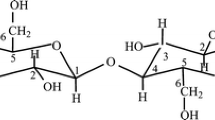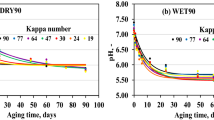Abstract
Wet cleaning of ancient papers is a common treatment performed for the removal of degradation products, external contaminants and salts, which can promote the degradation of cellulose (i.e., hydrolysis, oxidation). In this research, the effects on the mechanical properties of paper samples caused by wet cleaning treatments were evaluated by considering the changes induced in the ultimate tensile strength, deformation at break and flexibility. For this purpose, samples were subjected to different aqueous cleaning treatments such as immersion in deionised water and the application of rigid gels of agar and gellan gum at different concentrations was carried out. Tensile tests were run, and morphological observations of paper by means of light microscopy and scanning electron microscopy were recorded. Contrary to the significant changes in the mechanical properties of paper samples after immersion treatment (an increase in flexibility as the elongation at break), the use of gelled systems caused slight improvement in the mechanical properties of paper (in both the ultimate tensile strength as well as in the breaking strain). Changes in the mechanical properties of paper were also correlated with slight changes in the diameter of the cellulose fibres as a consequence of the swelling action of water molecules, especially in the case of immersion treatment. Finally, the tensile tests performed on the paper samples after thermo-hygrometric accelerated artificial ageing (70 °C and 65 % RH) demonstrated that cleaning treatments by rigid gels did not seem to accelerate any sort of paper degradation in the mid to long term.













Similar content being viewed by others
References
Araki C (1956) Structure of agarose constituent of agar–agar. Bull Chem Soc Jpn 29:43–44
Brückle I (2011) Aqueous Treatment in Context. In: Banik G, Brückle I (eds) Paper and water, a guide for conservators. Taylor Francis Ltd, Oxford, pp 419–436
Campani E, Casoli A, Cremonesi P, Saccani I, Signorini E (2007) Use of agarose and agar for preparing rigid gels. Quaderno n.4/Cesmar7. Il Prato Casa Editrice, Saonara (Padova)
Caulfield DF, Nissan AH (2001) Paper: effects of moisture and temperature. In: Encyclopedia of materials: science and technology. Elsevier, pp 6659–6669
Cremonesi P (2012) L’ambiente acquoso per il trattamento di opere policrome. Il Prato casa Editrice, Saonara (Padova)
Erhardt D, Tumosa CS, Mecklenburg MF (1999) Material consequence of the aging of paper. In: 12th Triennal Meeting Lyon, vol II, pp 501–506
Erhardt D, Tumosa Charles S, Mecklenburg MF (2000) Chemical and physical changes in naturally and accelerated aged cellulose. In: Historic textiles, paper and polymer in museums, Chapter 3. American Chemical Society, pp 23–37
Federici C, Rossi L (1983) Manuale di conservazione e restauro del libro. La Nuova Italia Scientifica, Roma
Freeman R (2004) Quantifying gelatine sizing loss during aqueous conservation treatments. Senior specialization project, Graduate Program in Art Conservation: Buffalo State College, pp 1–9
Hearle JWS, Lomas B, Cooke WD (1998a) GRANULAR FRACTURE, Solution-spun fibers. Atlas of fibre fracture and damage to textiles, vol Second Edition. Woodhead Publishing, Cambridge, pp 57–66
Hearle JWS, Lomas B, Cooke WD (1998b) FIBRILLAR FRACTURE, Wet cotton. Atlas of fibre fracture and damage to textiles, vol Second Edition. Woodhead Publishing, Cambridge, pp 67–68
Hearle JWS, Lomas B, Cooke WD (1998c) COTTON. Atlas of fibre fracture and damage to textiles, vol Second Edition. Woodhead Publishing, Cambridge, pp 133–137
Iannuccelli S, Sotgiu S (2010) Wet treatments of work of art on paper with rigid gellan gels. In: The Book and Paper Group Annual 29, pp 25–39
Iannuccelli S, Sotgiu S, Isca C (2012) Generalità sul Gellano: struttura chimica, proprietà, applicazioni. In: La pulitura a umido di opere d’arte su carta con gel rigidi di Gellano: presupposti teorici, metodologia applicativa e verifica analitica. Quaderno n.11/Cesmar7, Il Prato Casa Editrice, Saonara (Padova), pp 23–36
Isca C (2014) The use of polysaccharide rigid gels. Multi analytical approach for the study of their performance, effectiveness and interference with paper artworks, PhD thesis in Chemical Science, University of Parma
Kato KL, Cameron RE (1999) Structure-property relationships in thermally aged cellulose fibers and paper. J Appl Polym Sci 74(6):1465–1477
Kelco CP (2007) KELCOGELgellan gum Book. Vth Edn., http://www.appliedbioscience.com/docs/Gellan_Book_5th_Edition.pdf. Accessed 03 Sept 2012
Khandekar N (2000) A survey on the conservation literature relating to the development of aqueous gel cleaning on painted and varnished surfaces. Rev Conserv 1:10–20
Kosek MJ (2011) Washing paper in conservation. In: Banik G, Brückle I (eds) Paper and water, a guide for conservators. Taylor Francis Ltd, Oxford, pp 313–339
Leopold B, McIntosh DC (1961) Chemical composition and physical properties of wood fibers. III. Tensile strength of individual fibers fro alkali extracted loblolly pine holocelluloses. Tappi 10(3):235–240
Mazzuca C, Bocchinfuso G, Cacciotti I, Micheli L, Palleschi G, Palleschi A (2013) Versatile hydrogels: an efficient way to clean paper artworks. RSC Adv 3:22896–22899
Mazzuca C, Micheli L, Marini F, Bevilacqua M, Bocchinfuso G, Palleschi G, Palleschi A (2014a) Rheoreversible hydrogels in paper restoration processes: a versatile tool. Chem Cent J 8(10):1–11
Mazzuca C, Micheli L, Carbone M, Basoli F, Cervelli E, Iannuccelli S, Sotgiu S, Palleschi A (2014b) Gellan hydrogel as a powerful tool in paper cleaning process: a detailed study. J Colloid Interface Sci 416:205–211
McIntosh DC (1963) Tensile and bonding strengths of loblolly pine kraft fibers coked to different yields. Tappi 46(5):273–277
Mecklenburg MF, Fuster Lopez L (2008) Study of the mechanical and dimensional properties of painting materials. Universidad Politecnica de Valencia, Valencia
Miyoshi E, Takaya T, Nishinari K (1995) Effects of salts on the gel-sol transition of gellan gum by differential scanning calorimetry and thermal scanning rheology. Thermochim Acta 267:269–287
Morris VJ, Kirby AR, Gunning AP (1999) A fibrous model for gellan gels from atomic force microscopy studies. Prog Colloid Polym Sci 114:102–108
Noda S, Funami T, Nakauma M, Asai I, Takahashi R, Alassaf S, Ikeda S, Nishinari K, Phillips G (2008) Molecular structures of gellan gum imaged with atomic force microscopy in relation to the rheological behavior in aqueous systems. 1. Gellan gum with various acyl contents in the presence and absence of potassium. Food Hydrocoll 22(6):1148–1159
Page DH, Seth RS, El-Hosseiny F (1986) Strength and chemical composition of wood pump fibers. In: Anthony Bristow J, Kolseth P (eds) PAPER Structure and Properties. Marcel Dekker Inc, Basel, pp 77–91
Schaeffer TT (1995) A semiquantitative assay, based on TAPPI method, for monitoring changes in gelatine content of paper due to treatments. J Am Inst Conserv 34:95–105
Spiegelberg HL (1966) The effects of hemicelluloses on the mechanical properties of individual pulp fibers. Tappi 49(9):388–396
Uchida Y, Inaba M, Kijima T (2007) Evaluation of aqueous washing methods of paper by the measurement of organic acid extraction. Restaurator 28(3):169–184
Wolbers R (2003) Cleaning painted surfaces, Aqueous methods. Archetype Publications, London
Wolbers R (2004) Un approccio acquoso alla pulitura dei dipinti. Quaderno n.1/Cesmar7, Il Prato Casa Editrice Saonara (Padova), 48 p
Acknowledgments
This research was possible thanks to the financial support from the UPV Programa de Incentivo a la Investigación (PAID-UPV-06-10-2429). The authors are grateful to Dr. M.F. Mecklenburg (Museum Conservation Institute-Smithsonian Institute, USA) for the equipment donated. The authors also wanted to thank M. Planes and Dr. Moya (Microscopy Service, UPV) as well as Dr. Osete (Instituto de Restauración del Patrimonio-UPV) for their technical assistance.
Author information
Authors and Affiliations
Corresponding author
Rights and permissions
About this article
Cite this article
Isca, C., Fuster-López, L., Yusá-Marco, D.J. et al. An evaluation of changes induced by wet cleaning treatments in the mechanical properties of paper artworks. Cellulose 22, 3047–3062 (2015). https://doi.org/10.1007/s10570-015-0712-1
Received:
Accepted:
Published:
Issue Date:
DOI: https://doi.org/10.1007/s10570-015-0712-1




